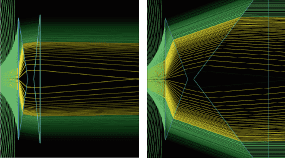Welcome to the latest selection of recent top articles in the physica status solidi journals. Get a glimpse of our publication spectrum and visit our pages by clicking on any of the DOI links below.
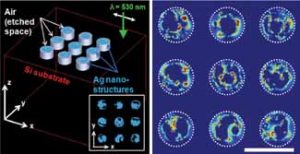
Topographically controlled growth of silver nanoparticle clusters
Jung-Sub Wi, Lok Kumar Shrestha, and Tadaaki Nagao
The authors present a method for promoting the nucleation of Ag nanoparticles by using lithographically defined Si nanowells. The preferred heterogeneous nucleation of Ag nanoparticles allows for the localization of Ag nanoparticle clusters inside the Si nanowell and the formation of regular arrays of surface-enhanced Raman scattering (SERS) active sensors. Highly enhanced surface plasmon fields at the Ag nanoparticle clusters were confirmed by three-dimensional electromagnetic simulation and by increased Raman intensities. Based on these results, the combination of top-down nanoscale templating and bottom-up nanoparticle synthesis using a broad range of materials, array designs, and applications, can be envisioned.
Phys. Status Solidi RRL (2012) DOI 10.1002/pssr.201206082
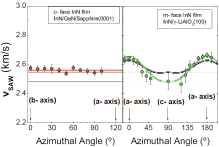
Surface acoustic waves and elastic constants of InN epilayers determined by Brillouin scattering [Rapid Research Letter]
R. J. Jiménez-Riobóo, R. Cuscó, N. Domènech-Amador, C. Prieto, T. Yamaguchi, Y. Nanishi, and L. Artús
This Letter presents a study of the elastic constants of InN by means of Brillouin scattering. The sagittal and azimuthal dependence of the surface acoustic wave velocity have been experimentally determined on c – and m -face epilayers. The authors analyse these results in comparison with simulations based on the Green’s function formalism, and they propose a complete set of elastic constants for c -face and m -face wurtzite InN.
Phys. Status Solidi RRL (2012) DOI 10.1002/pssr.201206132
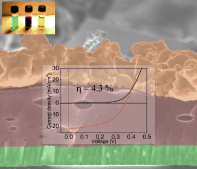
Cu2ZnSnSe4 absorbers processed from solution deposited metal salt precursors under different selenization conditions [Editor’s Choice]
C. M. Fella, A. R. Uhl, Y. E. Romanyuk, and A. N. Tiwari
Cu2ZnSnSe4 (CZTSe) thin film solar cells are fabricated by a simple, non-vacuum deposition of metal salts dissolved in non-hazardous solvents followed by selenization in Se atmosphere. Despite a residual carbon-rich layer between the back contact and the CZTSe absorber layer, solar cells with up to 4.28% conversion efficiency are obtained for Cu-poor and Zn-rich CZTSe absorbers. A frequently reported problem, the loss of tin, is investigated with respect to the influence of the selenization conditions such as substrate temperature and selenium partial pressure. EDX point measurements directly confirm that the remaining decomposed layer consists of a mixture of binary ZnSe and Cu2–xSe phases for too high substrate temperature and deficient Se supply.
Phys. Status Solidi A (2012) DOI 10.1002/pssa.201228003
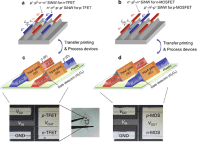
Comparative performance analysis of silicon nanowire tunnel FETs and MOSFETs on plastic substrates in flexible logic circuit applications [Original Paper]
Myeonwon Lee, Youngin Jeon, Kyung Sik Son, Joon Hyung Shim, and Sangsig Kim
Lee et al. report on the fabrication and electrical comparison between flexible tunnel field-effect transistors (TFETs) and MOSFETs on plastic substrates from device to circuit performance by use of fully CMOS-compatible silicon nanowires (SiNWs) as the channel material. The SiNW TFETs exhibit an ION/IOFF ratio of ∼105, which is about an order of magnitude lower than that of their MOSFET counterparts. The SiNW complementary TFET inverter shows ultralow DC power consumption, about 3–4 orders of magnitude lower than the SiNW CMOS inverter. Due to the different pros and cons for each of these devices, the authors’ top–down approach opens up the opportunity to integrate SiNW TFETs and MOSFETs on one plastic substrate for flexible hybrid integrated circuits, where both high-performance and low-power functionality are required.
Phys. Status Solidi A (2012) DOI 10.1002/pssa.201127767
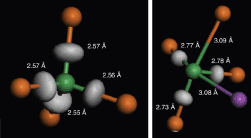
Amorphous phase of GeTe-based phase-change memory alloys: polyvalency of Ge–Te bonding and polyamorphism [Original Paper]
A. V. Kolobov, P. Fons, M. Krbal, and J. Tominaga
The structure of the amorphous phase of GeTe-based phase-change materials is discussed. Comparison of the Ge(4):Te(2) and Ge(3):Te(3) configurations, which are present in the amorphous phase, suggests that the former is locally more stable while the latter can lower its energy due to “resonance” interactions in structures within more extended order. The authors further demonstrate that polyvalency of the Ge–Te bonds can lead to the formation of negative-U defects accounting for the high resistivity of the amorphous phase. Finally, polyamorphism of the amorphous phase of Ge2Sb2Te5 is discussed.
Phys. Status Solidi A (2012) DOI 10.1002/pssa.201100752
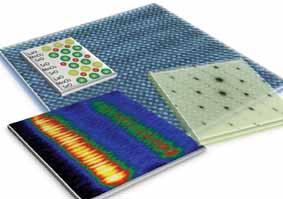
Structurally induced magnetization in a La2/3Sr4/3MnO4 superlattice
Amish B. Shah, Brittany B. Nelson Cheeseman, Ganesh Subramanian, Anand Bhattacharya, and John C. H. Spence
La2/3Sr4/3MnO4 (LSMO) can exhibit anisotropic electrical transport properties in bulk crystals. Artificial layered heterostructures offer the possibility of confining magnetic moments to two dimensional sheets and increasing the anisotropy compared to bulk crystals. A LSMO cation ordered superlattice grown by molecular beam epitaxy showed a large enhancement of magnetization in the out-of-plane direction upon cooling the sample below 110 K. Atomic-resolution structural analysis of the sample shows the formation of nanopatches of incoherency to the underlying SrTiO3 substrate when cooling the sample below 150 K. This structural transition observed only in superlattices leads to an enhancement of magnetic moment in the out-of-plane direction.
Phys. Status Solidi A (2012) DOI 10.1002/pssa.201127728
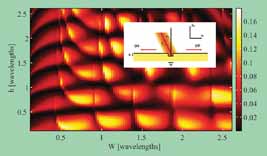
Compact surface structures for the efficient excitation of surface plasmon-polaritons
S. de la Cruz, E. R. Méndez, D. Macías, R. Salas-Montiel, and P. M. Adam
The ability to couple volume propagating optical waves into surface plasmon-polaritons (SPPs) in small and confined spaces is crucial for the development of plasmonic circuits. Based on rigorous electromagnetic methods, de la Cruz et al. study the excitation of SPPs through surface structures of nanometric dimensions, illuminated by focused beams. The authors consider steps, grooves and angled steps, and calculate efficiency maps for these structures as functions of the parameters that define them. They also study the efficiency associated with sequences of a small number of grooves and find that such compact structures can couple about 45% of the light into a directional SPP.
Phys. Status Solidi B (2012) DOI 10.1002/pssb.201100757
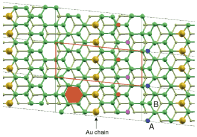
Optical characterization of gold chains and steps on the vicinal Si(557) surface: theory and experiment [Editor’s Choice]
Conor Hogan, Niall McAlinden, and John F. McGilp
Hogan et al. present a joint experimental–theoretical study of the reflectance anisotropy of clean and gold-covered Si(557), a vicinal surface of Si(111) upon which gold forms quasi-1D chains parallel to the steps. By means of first-principles calculations, the authors analyse the close relationship between the various surface structural motifs and the optical properties. Good agreement is found between experimental and computed spectra of single-step models of both clean and Au-adsorbed surfaces. Spectral fingerprints of monoatomic gold chains and silicon step edges are identified. The role of spin–orbit coupling on the surface optical properties is examined, and found to have little effect.
Phys. Status Solidi B (2012) DOI 10.1002/pssb.201100759
Negative refraction in anisotropic metamaterials [Original Paper]
Carlos Prieto-López and Rubén G. Barrera
In this article, the dispersion relations of two self-propagating modes in an arbitrary anisotropic uniaxial metamaterial are derived. The light refraction and reflection characteristics of a flat interface between this anisotropic metamaterial and an isotropic one are studied. The authors confirm that having a negative perpendicular component of the tensorial optical response, is an equivalent condition of having negative refraction of the corresponding mode. They also find conditions for the existence of a critical refraction angle as well as the Brewster angle and conditions for constructing materials with constant reflectance, which can be in particular non-reflective. The authors use these results to propose the design of a diffuse-light collimator with a high efficiency and simple geometry.
Phys. Status Solidi B (2012) DOI 10.1002/pssb.201100747

